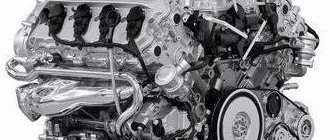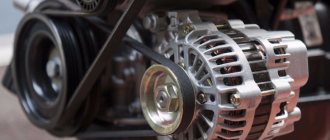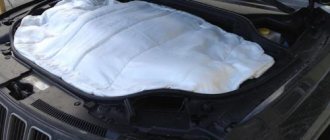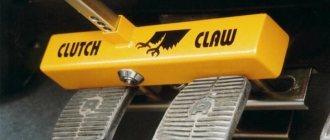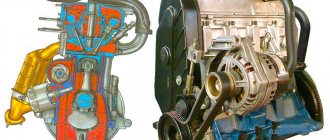Sometimes situations happen when a working car engine does not start. This may be due to the following factors, for example:
- discharged battery;
- failure to comply with cold start requirements (pressing the gas pedal when starting a fuel-injected car, not using the carburetor trigger, also known as “choke”, using low-quality or inappropriate motor oils for the season);
- ignition system malfunction;
- fuel system malfunction;
- malfunction of the starting system (injection engines and diesel CDI);
- abnormal activation of the anti-theft system and other reasons;
How to start a car after a long period of inactivity
As for cars that sit idle in warm garages for 6-12 months, then the battery will require the closest attention. If the battery has not been removed and the terminals are screwed to the battery, then a deep discharge is quite likely. This battery must be removed and charged before starting. You can also use a jump charger to make starting easier or completely replace the battery with a new one if the battery malfunctions.
We also recommend reading the article on how to properly store a car battery. From this article you will learn about the features of battery storage and methods of preliminary battery preparation.
After starting the engine, it is also necessary to visually inspect the engine compartment for the integrity of the pipes and possible leaks, check the fluid level and tire pressure.
If the car has been standing on the street for a long time: first start
Trying to start a car after a long period of parking outside during the cold season is considered especially harsh conditions. Before starting the engine for the first time after a long period of inactivity in the cold, you need to first prepare the car. Trying to start the engine right away is strictly prohibited!
To begin with, the issue with the battery is resolved, which will depend on the duration of the downtime (recharging an existing battery with a performance check or preparing another battery that is known to work).
Let us add that if the car has been standing for about a year, then there is a high probability of “revitalizing” the old battery by charging. A machine sitting idle for 2 years or more means that a new battery will be needed.
Actions for a car owner to start the engine easily in winter
Many owners of any equipment experience difficulty starting the engine at low and sub-zero temperatures. This is primarily due to the fact that the viscosity of the oil increases, which prevents the starter from developing the maximum speed necessary to create the required pressure in the engine cylinders necessary to ignite the combustible mixture. This is especially important for diesel engines.
Motorists who operate equipment in winter need to pay attention to the battery, since starting the engine at any time of the year depends on its condition. Especially in winter.
To do this, you need to carry out its maintenance. First of all, check the electrolyte density and bring it to 1.28-1.29, which corresponds to operating standards for the most severe winter conditions. If the battery is 3 or more years old, it is advisable to replace it with a new one, since their resource is pretty much used up.
Before cold weather sets in, change the engine oil to one designed for winter use, which has a lower viscosity, which will lighten the load on the starter and battery.
Following these simple steps, provided that there are no problems with the engine, will allow you to start the engine without difficulty. At least at air temperatures down to -10 degrees.
If the equipment is located in a garage and there is electricity in it, then you can resort to devices for heating air and coolant, which will make it easier to start the engine.
To do this, use dry air heaters in the form of heaters of various modifications and heat guns that can raise the temperature in the engine compartment. When heat enters the air cleaner, a high-quality combustible mixture is formed, which will make it easier to start a cold engine.
Coolant heaters are also now available for sale, which are mounted in the engine cooling system and operate from the electrical network. By turning it on 1-2 hours before the intended trip, you will have a warmed-up engine.
It would be a good idea to insulate the engine compartment and radiator. This will slow down the cooling of the engine during long periods of parking.
The condition of the motor itself is of great importance. If it malfunctions in the warm season, then at subzero temperatures it can cause a lot of trouble during startup and during operation.
Before winter frosts, it is necessary to carry out maintenance of the generator, starter and other electrical equipment. It is advisable to do all this in a qualified workshop. Also fill up with quality fuel. Then in cold weather there will be no problems starting the engine.
Checking technical fluids
It is also necessary to carefully check the level and condition of all technical fluids: engine oil, brake fluid, power steering fluid (power steering), transmission oil level (if possible), cooling system coolant level in the expansion tank. All fluids must be filled in full before starting. A decrease in level or an empty tank will indicate a malfunction in the form of leaking pipes, gaskets, seals, etc. It is worth checking the fluids most closely in the most important components (engine oil, cooling system, fuel system).
Engine oil condition
Motor oil tends to age not only with mileage, but also with time. The shelf life of the lubricant that is poured into the engine is very limited and is about 12 months. Moreover, if the engine is in operation, the additive package tends to mix with the base. When a car sits for a long time, the additives settle and the oil simply separates. For this reason, it is necessary to evaluate the condition of the lubricant.
If the oil is very thick, black, and contains impurities and debris, then it is better not to start the engine. This oil is drained, after which the flushing composition is poured. Next, you can add fresh lubricant and replace the oil filter.
Fuel in tank
Gasoline or diesel fuel tends to accumulate moisture (condensation). If the car is prepared for parking in advance, then the tank is 2/3 filled with high-quality fuel, which must be drained before starting. As for unprepared vehicles, there is a high probability that there will be spoiled fuel in the fuel tank, which must be drained.
Coolant
To check, just unscrew the cap of the expansion tank and assess the condition of the coolant. If the level is within acceptable limits, there are no visible “flakes” or other contaminants, then you can drive several kilometers on such a liquid, carefully monitoring the engine temperature. Next, the fluid will need to be changed, after flushing the cooling system.
Brake fluid
Currently reading
Device, repair of muffler resonator
How often to change the timing belt on a car: what you need...
One of the properties of brake fluid is hygroscopicity, which means the accumulation of moisture. Under normal conditions, brake fluid is changed once every two years. If the car has been sitting for a long time, then before the first trip the fluid is drained and the brakes need to be bled.
Next, be sure to check the brake pads and brake discs themselves. Loose linings on the pads make them unsuitable for further use.
If the brake discs are covered with rust, then when starting to move, lightly hold your foot on the brake, thus driving several tens of meters. The rust must be removed.
Causes of malfunction
Before we begin to study the causes of the malfunction, we remind you that hereinafter we are talking about the crackling noise of the starter, which is most similar to the loud rattling of the contacts of an electromagnetic relay. If you hear an unpleasant metallic grinding noise from under the hood, then it appears due to poor engagement of the overrunning clutch (starter Bendix) with the flywheel teeth - that’s a completely different story.
Most often, the starter crackles when you turn the ignition key for three reasons:
Low battery
To understand the cause of the crackling noise due to a discharged battery, let's remember the starter device. When you turn the ignition key, the voltage from the on-board network is supplied to the coil of its solenoid relay. The electromagnetic forces that appear in this case cause the armature of the device to move. It closes the power contacts that connect the starter motor to the battery, and in addition, causes the Bendix gear to engage with the flywheel.
When the battery is discharged, its energy may be enough to attract the metal core - cranking the crankshaft is out of the question. As soon as the starter contacts close and power is supplied to its electric motor, the voltage drops to such an extent that the electromagnet is unable to hold the metal core. Under the action of the return spring, it tends to take its original position and opens the power contacts. The restored voltage contributes to the repeated retraction of the anchor, and the situation is recreated many times.
Additional checks and preparations
At the initial stage, it is necessary to carefully inspect all gaskets and hoses of the main components. If the car has been standing for up to 3-4 years, then the rubber products may still be rejected by workers.
A longer downtime may mean that the rubber has dried out and cracked. First of all, check the fuel line and cooling system pipes.
We also recommend reading the article on how to start a car using a jump charger. From this article you will learn about the advantages of this solution compared to other methods of starting an engine with a dead battery.
Before starting, it is advisable to change the spark plugs on a gasoline engine, and also inject a small amount of engine oil into the cylinders through the spark plug wells. After this, the engine without spark plugs must be cranked with the starter to remove any remaining oil, and then new spark plugs must be screwed in. For a diesel engine, the procedure is similar, only in this case the glow plugs are changed.
1.6.5. Actions in case of engine start failure
1.6.5. Actions in case of engine start failure
| GENERAL INFORMATION |
Simple checks
Before checking, make sure that you have exactly followed the steps described in subsection 1.6 and that the car is filled with a sufficient amount of fuel. If the car is equipped with an engine start coding system (immobilizer), then start the engine with other keys from the kit. If the engine starts, the cause is a broken ignition key. Check the key at a car service center. If you cannot start the engine using other keys, contact a car service center, as the anti-theft system may fail.
| EXECUTION ORDER | ||||||||||||||
| Starting the engine if the cylinders are overfilled with gasoline In the event of a starting failure, the engine cylinders may be overfilled with gasoline due to repeated unsuccessful starting attempts.
|
Engine starting
Once all preparations are complete, you can try to start the engine. You need to start it carefully, if necessary, purging the cylinders by pressing the gas pedal once, as well as depressing the clutch pedal on cars with manual transmission. Do not turn the engine with the starter for more than 10 seconds!
If the engine does not start, then a pause must be made between attempts. After successfully starting the engine and warming up a little, the clutch can be released smoothly. If jerking is detected when releasing the clutch pedal, you must depress the pedal again and then try again.
